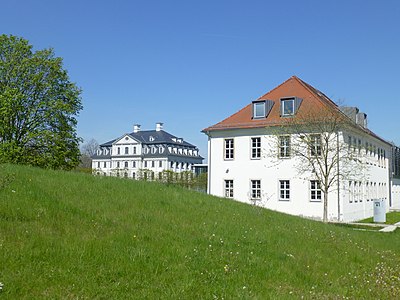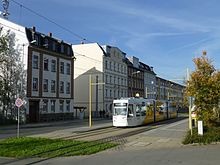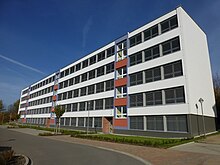Tinz (Gera)
|
Tinz
City of Gera
Coordinates: 50 ° 54 ′ 9 ″ N , 12 ° 4 ′ 23 ″ E
|
|
|---|---|
| Height : | 202 m above sea level NN |
| Residents : | 1364 (Dec. 31, 2013) |
| Incorporation : | January 1, 1919 |
| Postal code : | 07546 |
| Area code : | 0365 |
Tinz is a district of Gera in Thuringia.
location
Tinz belongs to the statistical district of Bieblach / Tinz in the north of the city of Gera . The northern border is the federal motorway 4 . To the west, Tinz extends into the lowland of the White Elster .
history
Tinz goes back to a foundation of the West Slavic tribe of the Sorbs , who settled the areas east of the Saale in the 7th and 8th centuries . In the years 1885 and 1963 excavations took place in the area of the industrial park Siemensstrasse north of the Brahme. The here exposed iron smelting furnaces. From Germanic and ceramic finds from the Slavic period proved that the Slavs settled in the Elsteraue, abandoned by the Teutons , and built a palisade fortress with a moat at the confluence of the Brahmetal and the Elstertal. The name Tinz is probably derived from this: The Slavic word tynec can be translated with fencing or stake fence.
A document from the Naumburg bishop Udo II von Veldenz , dated May 25, 1168, is the oldest document that "Thinz" is mentioned for the first time in connection with the gentlemen "Luf" and "Heinrich von Thinz" mentioned as witnesses. At this time the abbess of the Quedlinburg Imperial Abbey was responsible for the corridor . In December 1290, Margrave Friedrich von Meißen pledged the allodium Tyncz to the Plauener Vogt Heinrich I the Elder (1238-1303). Three years later, in 1293, the bailiffs of Weida received the property Tinz and sold it in 1331 to Heinrich IV. (1305-1343), bailiff of Gera. With the construction of a medieval moated castle, the gentlemen of Gera Tinz expanded as "Forwergk". After the line of the bailiffs of Gera died out in 1550 - Heinrich XV. died childless - the lands of Tinz went to the titular castle count of Meißen , the older branch of the bailiffs of Plauen. After the castle counts' line of Meißen and Plauen died out in 1572, all the property went to the Reuss-Gera Jüngere Line. At that time, Tinz was still an irregularly parceled street village and developed on the Nuremberg-Leipzig trade route into a trading center north of Gera.
Tinz also became famous for its fair, the stalls of which were built around the Tinz church on July 13th, Margaret's Day, every year until 1540. Due to the indulgence on Margaret's Day and the associated pilgrimage, the Tinzer Margaretenkirche was closely connected to the fair and around 1472 an extension in the late Gothic style became necessary. Until the introduction of the Reformation in 1533 the pastor of Tinzer was St. Margaret also lock Kaplan on the castle Easter stone . In a visit to the Lutheran superintendent in 1534, the pastor was severely judged because he preached sometimes Lutheran and sometimes papal. He was abolished “as a useless boy” and the Tinz parish was taken care of by the main church in Gera.
In addition to the old village church, the action also took place around the chamber property and the moated castle on the north-western edge of the original town center. In 1745 Count Heinrich XXV. von Reuß-Gera (1681–1748) expanded the ensemble of buildings of the already existing chamber property into a two-winged farmyard and commissioned the construction of a three-storey castle with surrounding moats in the immediate vicinity. His son, Heinrich XXX. von Reuss-Gera (1727–1802), is considered to be the creator of the extensive park in the French style adjoining it to the west and completed the first summer residence of the Reuss Younger Line family.
On January 1, 1919, Tinz was incorporated into the city of Gera , initially without the castle district . In the 1920s and 1930s, several single and row house settlements were built (Rosenberg, Heimatscholle settlement). Due to the large number of large industrial companies located there (brewery, gas works, foundry), Tinz was an important bombing target at the end of the Second World War . On February 6, 1945, the district nursing home was also hit: 50 people died.
Attractions
- Tinz Castle , built from 1745 to 1748 under Heinrich XXV. Reuss-Gera. The former moated castle and its outdoor facilities are currently being extensively renovated and are to be used by the Gera-Eisenach Cooperative State University (DHGE) from 2017 . From 1920 until its closure by the National Socialists in 1933, the Tinz Castle, which was oriented towards social democracy, housed the Tinz folk high school.
- St. Margareten , a former pilgrimage church with a late Gothic winged altar.
politics
Tinz has no district council and no district mayor .
Development of the population
| year | 1647 | 1794 | 1841 | 1867 | 1875 | 1891 | 1909 | 1941 | 1995 | 2008 |
|---|---|---|---|---|---|---|---|---|---|---|
| Residents | 67 | 106 | 191 | 315 | 450 | 768 | 997 | 2295 | 1603 | 1406 |
Transport and infrastructure
The street village of Tinz, located on the important medieval trade route Nuremberg - Leipzig , quickly developed into a well-known marketplace north of Gera. The strategically favorable location has led to an economic boom and a significant expansion of the infrastructure over the past two centuries.
On February 22, 1892, the Debschwitz - Tinz tram line was opened with 16 stops over a total length of 5.2 km. Tinz was one of the first towns in Germany to have its own connection to the electric tram and until 1986 was the northern end of the Gera tram network . In 1986 the line was extended to the Bieblach-Ost development area . As part of the Gera light rail program, the Tinz turning loop was demolished in 2007/2008, after it had only been used during rush hour schedules since 1996. At the same time, the Berufsakademie stop (now a dual university) was expanded into a new transfer point. This is now operated by RVG Regionalverkehr Gera / Land buses with regional and city lines. The new construction of tram line 4 to Langenberg , which is to branch off at the dual university, is in planning .
| line | operator | Line course | Frequency (Mon-Fri) |
|---|---|---|---|
| 3 | GVB | Bieblach-Ost - Tinz - Heinrichstrasse - Lusan | 5 / 7.5 min |
| 203 | RVG | Gera - Dual University - Bad Köstritz - Crossen an der Elster - Eisenberg | Every half hour (Gera - Bad Köstritz) with line 204 every two hours (Bad Köstritz - Eisenberg) |
| 204 | RVG | Gera - Dual University - Bad Köstritz - Bad Klosterlausnitz - Hermsdorf | Every half hour (Gera - Bad Köstritz) with line 203 every two hours (Bad Köstritz - Hermsdorf) |
| 228 | RVG | Cooperative State University - Langenberg - Hain / Steinbrücken - Großaga | Hourly |
| 229 | RVG | Cooperative State University - Langenberg - Wernsdorf / Kleinaga - Hermsdorf | Hourly |
In the summer of 1926, the first Gera airfield was inaugurated on a 36 hectare plot of land in Tinz. There were flight connections to Halle , Leipzig / Schkeuditz , Chemnitz and Plauen , among others . However, the airfield had to give way to the construction of the Reichsautobahn , which was opened to traffic on December 4, 1937. The access road to the Gera-Langenberg motorway junction, named after Werner von Siemens , was built in 1933 and cut the Tinzer Schlosspark into two parts.
At the beginning of the 1990s, the Tinz tank barracks was demolished and the foundation stone was laid for the Tinzer Strasse industrial park, where Deutsche Post AG operates one of its 99 mail centers in Germany. In addition, with the demolition of the motor vehicle repair plant and the Gera-Nord thermal power station, additional industrial areas were created in the immediate vicinity of the federal motorway 4.
Public facilities
Until 1968 there was a school in Tinz (Association School Tinz- Roschütz ). After their closure, the school building was converted into a kindergarten in the early 1970s and still houses the “Tinzer Spatzen” daycare center today . On October 22, 2002 the foundation stone was laid for the Gera University of Cooperative Education , which has been part of the Thuringian university landscape since September 1, 2016 as the Dual University Gera-Eisenach (DHGE) . Until the beginning of 2010, parts of the Gera Regional Court were housed in the immediately adjacent Tinz Castle, which moved to the city center when the new justice center was completed. In the future, the castle is to be used by the university, as its capacities are already heavily overloaded. Until the renovation of the Tinzer Schloss has been completed, part of the free space in the former district military replacement office in Gera (closed in 2008) will be used for the dual university. In the years 2010 to 2014, the renovation of the place in Tinz vocational school equipment and the construction of a new building extension at the site of the former swimming pool Tinz.
Individual evidence
- ^ Sigrid Dusek: Iron smelting furnaces in a Germanic settlement near Gera-Tinz . In: Old Thuringia . 9th volume, 1967, pp. 95-183 .
- ↑ Werner Seidel: Imperial and Slavic settlements in Gera-Tinz . Berlin 1964.
- ↑ Werner Seidel: A Germanic and a Slavic settlement in the Elsteraue near Gera-Tinz . In: Heimatpflege und Heimatforschung in the Gera district . 1964.
- ↑ Wolfgang Janka: Slavic in place names of the former districts of Oberviechtach and Neunburg vorm Wald . In: Oberviechtacher local history contributions . tape 8/2010 (conference proceedings). Oberviechtach 2010, p. 47 f .
- ↑ a b c d Alexander Jörk (Ed.): Building blocks of the local history of Gera-Tinz . 5th edition. Gera 2015.
- ^ Berthold Schmidt: Document book of the bailiffs of Weida, Gera and Plauen as well as their house monasteries Mildenfurth, Cronschwitz, Weida and the Holy Cross near Saalburg . tape 1 . Jena 1885.
- ↑ Robert Hansel: Reussische Genealogie . Jena 1940.
- ↑ Thomas Gehrlein: The Reuss House, Part I and II . In: German Princely Houses . Issue 49. Arnsberg 2015, p. 20 .
- ^ Berthold Schmidt: The Reussen. Genealogy of the entire Reuss house older and younger line . Schleiz 1903, p. Plate 3 .
- ↑ Anja Löffler: Cultural monuments in Thuringia - Volume 3: The city of Gera . Ed .: Thuringian State Office for Monument Preservation. 2007, p. 493 .
- ↑ Newspaper clipping "St. Margarethen-Jahrmarkt" . City archive Gera III F 26 / Kröhl - 172.
- ^ Ferdinand Hahn: History of Gera and its immediate surroundings . Gera 1855; P. 420.
- ↑ Anja Löffler: Tinz in Gera - A forgotten castle in East Thuringia . In: Castles and Palaces in Thuringia, annual publication of the Thuringia regional group of the German Castle Association . Jena 1998.
- ↑ Gera City Archives
- ↑ Siegfried Mues: The street name of the city of Gera from A to Z . Publishing house Dr. Frank GmbH, Gera 2006, p. 270 .




